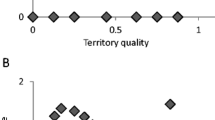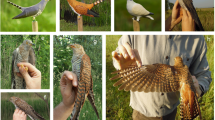Abstract
Alternative strategies are characterised by context-dependent fitness payoffs, which means that their fitness depends on the frequency and the nature of their interactions with one or more strategies. The analysis of the variation of the fitness of each strategy in different social environments can elucidate the evolutionary dynamics played by the strategies. In the common lizard, three female colour types (yellow, orange and mixed) are associated with alternative reaction norms in reproduction and social behaviour that signal alternative strategies. To clarify the nature of colour-specific interactions and their influence on female fitness, we analysed the response of female reproductive success to an experimental manipulation of colour frequencies in natural populations. We found that juvenile body condition at birth for all colour types was negatively affected by the local frequency of yellow females. In addition, we found that mixed females had higher clutch hatching success in the populations where orange females were frequent. These results prove that female reproduction is sensitive to the social environment, and are consistent with a scenario of a hawk–dove–bully game, in which yellow females are aggressive hawks, orange females non-aggressive doves, and mixed females have a context-dependent bully strategy. In this system, the plastic bully strategy would confer a reproductive advantage to putative heterozygotes in some social environments, which could allow the maintenance of the system through context-dependent overdominance effects.


Similar content being viewed by others
References
Andersson S (2000) Efficacy and content in avian colour signals. In: Espmark Y, Amundsen T, Rosenqvist G (eds) Animal signals. Tapir Academic Press, Trondheim, pp 47–60
Aubin-Horth N, Desjardins JK, Martei YM, Balshine S, Hofmann HA (2007) Masculinized dominant females in a cooperative breeding species. Mol Ecol 16:1349–1358. doi:10.1111/j.1365-294X.2007.03249.x
Bell DJ (1983) Mate choice in the European rabbit. In: Bateson P (ed) Mate choice. Cambridge University Press, Cambridge, pp 211–226
Bleay C, Comendant T, Sinervo B (2007) An experimental test of frequency dependent selection on male mating strategy in the field. Proc R Soc Lond B Biol 274:2019–2025. doi:10.1098/rspb.2007.0361
Brockmann HJ (2001) The evolution of alternative strategies and tactics. Adv Stud Behav 30:1–51
Comendant T, Sinervo B, Svensson EI, Wingfield J (2003) Social competition, corticosterone and survival in female lizard morphs. J Evol Biol 16:948–955. doi:10.1046/j.1420-9101.2003.00598.x
Cote J, Le Galliard JF, Rossi JM, Fitze P (2008) Environmentally induced changes in carotenoid-based coloration of female lizards: a comment on Vercken et al. J Evol Biol 21:1165–1172. doi:10.1111/j.1420-9101.2008.01534.x
Emlen DJ (1997) Alternative reproductive tactics and male dimorphism in the horned beetle Onthophagus acuminatus. Behav Ecol Sociobiol 41:335–341. doi:10.1007/s002650050393
Fisher RA (1930) The genetic theory of natural selection. Clarendon Press, Oxford
Gross MR (1991) Evolution of alternative reproductive strategies: frequency-dependent sexual selection in male bluegill sunfish. Phil Trans R Soc Lond B Biol 332:59–66. doi:10.1098/rstb.1991.0033
Gross MR (1996) Alternative reproductive strategies and tactics: diversity within sexes. Trends Ecol Evol 11:92–98. doi:10.1016/0169-5347(96)81050-0
Gross MR, Repka J (1998) Game theory and inheritance in the conditional strategy. In: Dugatkin L, Reeves HK (eds) Game theory and animal behavior. Oxford University Press, Oxford, pp 168–187
Henson SA, Warner RR (1997) Male and female alternative reproductive behaviors in fishes: a new approach using intersexual dynamics. Annu Rev Ecol Syst 28:571–592. doi:10.1146/annurev.ecolsys.28.1.571
Lecomte J, Clobert J, Massot M (1992) Sex identification in juveniles of Lacerta vivipara. Amphib-Reptil 13:21–25. doi:10.1163/156853892X00193
Lorenzon P, Clobert J, Massot M (2001) The contribution of phenotypic plasticity to adaptation in Lacerta vivipara. Evol Int J Prg Evol 55:392–404. doi:10.1111/j.0014-3820.2001.tb01302.x
Massot M (1992) Déterminisme de la dispersion chez le lizard vivipare. Ph.D. thesis, Université Paris-XI
Massot M, Clobert J, Pilorge T, Lecomte J, Barbault R (1992) Density dependence in the common lizard: demographic consequences of a density manipulation. Ecology 73:1742–1756. doi:10.2307/1940026
Massot M, Clobert J, Lecomte J, Barbault R (1994) Incumbent advantage in common lizards and their colonizing ability. J Anim Ecol 63:431–440
Massot M, Clobert J, Lorenzon P, Rossi JM (2002) Condition-dependent dispersal and the ontogeny of the dispersal behaviour: an experimental approach. J Anim Ecol 71:253–261. doi:10.1046/j.1365-2656.2002.00592.x
Maynard-Smith J (1982) Evolution and the theory of games. Cambridge University Press, Cambridge
Meylan S, Clobert J, Sinervo B (2007) Adaptive significance of maternal induced density-dependent phenotype. Oikos 116:650–661. doi:10.1111/j.0030-1299.2007.15432.x
Moller AP, Swaddle JP (1997) Asymmetry, developmental stability and evolution. Oxford University Press, Oxford
Olendorf R, Rodd FH, Punzalan D, Houde AE, Hurt C, Reznick DN, Hughes KA (2006) Frequency-dependent survival in natural guppy populations. Nature 441:633–636. doi:10.1038/nature04646
Roulin A (2004) The evolution, maintenance and adaptive function of genetic colour polymorphism in birds. Biol Rev Camb Phil Soc 79:815–848
Sinervo B, Calsbeek R (2006) The physiological, behavioural and genetical causes and consequences of frequency-dependent selection in the wild. Annu Rev Ecol Syst 37:581–610. doi:10.1146/annurev.ecolsys.37.091305.110128
Sinervo B, Clobert J (2003) Morphs, dispersal behavior, genetic similarity, and the evolution of cooperation. Science 300:1949–1951. doi:10.1126/science.1083109
Sinervo B, Lively CM (1996) The rock–paper–scissors game and the evolution of alternative male reproductive strategies. Nature 380:240–243. doi:10.1038/380240a0
Sinervo B, Zamudio K (2001) Genetic correlations between the sexes, fitness differentials, and the evolution of alternative reproductive strategies. J Hered 92:198–205. doi:10.1093/jhered/92.2.198
Sinervo B, Bleay C, Adamopoulou C (2001) Social causes of correlational selection and the resolution of a heritable throat color polymorphism in a lizard. Evol Int J Org Evol 55:2040–2052. doi:10.1111/j.0014-3820.2001.tb01320.x
Sinervo B, Heulin B, Surget-Groba Y, Clobert J, Miles DB, Corl A, Chaine A, Davies A (2007) Models of density-dependent genic selection and a new rock–paper–scissors social system. Am Nat 170:663–680. doi:10.1086/522092
Sirot LK, Brockmann HJ (2001) Costs of sexual interactions to females in Rambur’s forktail damselfly, Ischnura ramburi (Zygoptera: Coenagrionidae). Anim Behav 61:415–424. doi:10.1006/anbe.2000.1605
Sirot LK, Brockmann HJ, Marinis C, Muschett G (2003) Maintenance of a female-limited polymorphism in Ischnura ramburi (Zygoptera: Coenagrionidae). Anim Behav 66:763–775. doi:10.1006/anbe.2003.2279
Svensson EI, Abbott J (2005) Evolutionary dynamics and population biology of a polymorphic insect. J Evol Biol 18:1503–1514. doi:10.1111/j.1420-9101.2005.00946.x
Svensson E, Abbott J, Hardling R (2005) Female polymorphism, frequency dependence, and rapid evolutionary dynamics in natural populations. Am Nat 165:567–576. doi:10.1086/429278
Thompson CW, Moore MC (1991) Syntopic occurrence of multiple dewlap color morphs in male tree lizards, Urosaurus ornatus. Copeia 2:493–503
Van Gossum H, Stoks R, De Bruyn L (2005) Lifetime fitness components in female colour morphs of a damselfly: density- or frequency-dependent selection? Biol J Linn Soc 86:515–523. doi:10.1111/j.1095-8312.2005.00551.x
Vercken E, Clobert J (2008) Ventral color polymorphism correlates with alternative behavioural patterns in female common lizards (Lacerta vivipara). Ecoscience 15:320–326. doi:10.2980/15-3-3135
Vercken E, Clobert J (2009) The role of colour polymorphism in social encounters among female common lizards. Herpetol J 18:223–230
Vercken E, Massot M, Sinervo B, Clobert J (2007) Colour polymorphism in females and alternative reproductive strategies in the common lizard Lacerta vivipara. J Evol Biol 20:221–232. doi:10.1111/j.1420-9101.2006.01208.x
Vercken E, Sinervo B, Clobert J (2008) Colour variation in female common lizards: why we should speak of morphs, a reply to Cote et al. J Evol Biol 21:1160–1164. doi:10.1111/j.1420-9101.2008.01535.x
Weiss SL (2006) Female-specific color is a signal of quality in the striped plateau lizard (Sceloporus virgatus). Behav Ecol 17:726–732. doi:10.1093/beheco/arl001
Widemo F (1998) Alternative reproductive strategies in the ruff, Philomachus pugnax: a mixed ESS? Anim Behav 56:329–336. doi:10.1006/anbe.1998.0792
Acknowledgments
We are indebted to several undergraduate students (C. Cansell, B. Chéron, B. Khoury, T. Le Mao, V. Lecat and E. Serres) for their help in the field and the laboratory during the study period. We thank the Parc National des Cévennes and the Office National des Forêts for providing logistical support. We are most grateful to Raoul Van Damme and two anonymous referees for their suggestions and comments that contributed greatly to the improvement of this manuscript. The reported experiments comply with the current laws of France concerning animal experimentation.
Conflict of interest statement
The authors declare they have no conflict of interest.
Author information
Authors and Affiliations
Corresponding author
Additional information
Communicated by Raoul Van Damme.
Rights and permissions
About this article
Cite this article
Vercken, E., Clobert, J. & Sinervo, B. Frequency-dependent reproductive success in female common lizards: a real-life hawk–dove–bully game?. Oecologia 162, 49–58 (2010). https://doi.org/10.1007/s00442-009-1442-6
Received:
Accepted:
Published:
Issue Date:
DOI: https://doi.org/10.1007/s00442-009-1442-6




